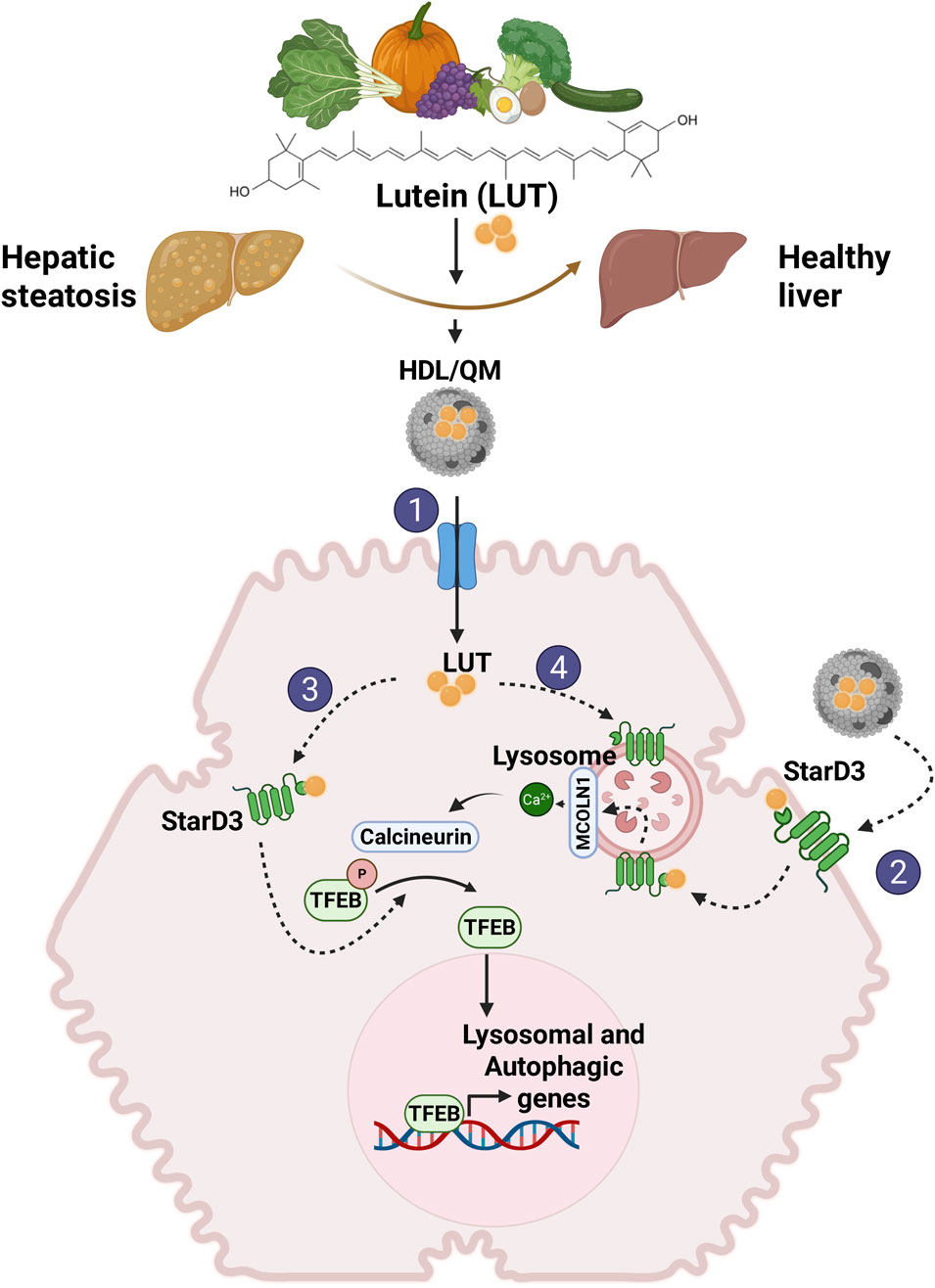- 1Center for Biomedical Research, Universidad Finis Terrae, Santiago, Chile
- 2Department of Gastroenterology, Faculty of Medicine, Pontificia Universidad Católica de Chile, Santiago, Chile
A Correction on
Exploring the lutein therapeutic potential in steatotic liver disease: mechanistic insights and future directions
by Balboa E, Saud F, Parra-Ruiz C, de la Fuente M, Landskron G and Zanlungo S (2024). Front. Pharmacol. 15:1406784. doi: 10.3389/fphar.2024.1406784
In the published article, there was an error in Figure 2 as published. In the section of the figure labeled as “Step 2,” where STARD3 is shown at the plasma membrane, it is depicted with its N-terminal and C-terminal domains oriented toward the extracellular space. However, both the N- and C-terminal domains of STARD3 must be cytoplasmic. The corrected Figure 2 and its caption appear below.

Figure 2. Proposed mechanisms involved in lutein-mediated hepatoprotective effects. We propose that independent of its antioxidant and antiapoptotic activity, lutein stimulates LD autophagy in the liver, reducing their accumulation and improving steatosis. This action is mediated through the activation of TFEB. Given lutein’s hydrophobic nature as a carotenoid, an intracellular transporter is required to exert its activity within the cell. We propose that STARD3 serves as this transporter. 1) To enter the cell, lutein in lipoproteins, primarily QM and HDL, binds to their transporters on the hepatocyte membrane (SRBI, LDLR, LRP1). 2) Additionally, lutein may directly enter the cell by binding to STARD3 on the plasma membrane. 3) Once inside the cell, lutein bound to STARD3 would directly or indirectly interact with TFEB, mediating its activation. 4) Another pathway for lutein entry involves endosomal uptake, where it binds to STARD3 in the lysosome, activating TFEB via the MCOLN1/Ca2+/calcineurina pathway.
The original version of this article has been updated.
Publisher’s note
All claims expressed in this article are solely those of the authors and do not necessarily represent those of their affiliated organizations, or those of the publisher, the editors and the reviewers. Any product that may be evaluated in this article, or claim that may be made by its manufacturer, is not guaranteed or endorsed by the publisher.
Keywords: hepatic steatosis, lipophagy, lutein, TFEB, StARD3, lipid droplet
Citation: Balboa E, Saud F, Parra-Ruiz C, Fuente Mdl, Landskron G and Zanlungo S (2025) Correction: Exploring the lutein therapeutic potential in steatotic liver disease: mechanistic insights and future directions. Front. Pharmacol. 16:1633575. doi: 10.3389/fphar.2025.1633575
Received: 23 May 2025; Accepted: 12 June 2025;
Published: 25 June 2025.
Edited and reviewed by:
Anna Cantalupo, Mount Sinai Hospital, United StatesCopyright © 2025 Balboa, Saud, Parra-Ruiz, Fuente, Landskron and Zanlungo. This is an open-access article distributed under the terms of the Creative Commons Attribution License (CC BY). The use, distribution or reproduction in other forums is permitted, provided the original author(s) and the copyright owner(s) are credited and that the original publication in this journal is cited, in accordance with accepted academic practice. No use, distribution or reproduction is permitted which does not comply with these terms.
*Correspondence: Elisa Balboa, ZWJhbGJvYUB1ZnQuY2w=
 Elisa Balboa
Elisa Balboa Faride Saud
Faride Saud Claudia Parra-Ruiz
Claudia Parra-Ruiz Marjorie de la Fuente
Marjorie de la Fuente Glauben Landskron
Glauben Landskron Silvana Zanlungo
Silvana Zanlungo